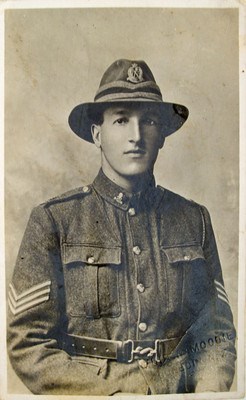Sgt
Joseph Albert Stenning
Information about birth
|
Date of birth: 06/02/1893 |
|
Place of birth: Owaka, Clutha, Otago, New Zealand |
General information
|
Last known residence: Pounawea, Catlins, Clutha, Otago, New Zealand |
|
Profession: Carpenter |
|
Religion: Presbyterian |
Army information
|
Country: New Zealand |
|
Force: New Zealand Expeditionary Force |
|
Rank: Sergeant |
|
Service number: 41116 |
|
Enlistment date: 11/11/1916 |
|
Enlistment place: Balclutha, Clutha, Otago, New Zealand |
|
Units: — New Zealand Rifle Brigade, 2nd Bn. (Last known unit) |
Information about death
|
Date of death: 12/10/1917 |
|
Place of death: Waterfields, Passchendaele, Belgium |
|
Cause of death: Killed in action (K.I.A.) |
|
Age: 24 |
Cemetery
|
Passchendaele New British Cemetery Plot: VIII Row: 5 Grave: 5 |
Distinctions and medals 2
|
British War Medal Medal — 28/11/1921 |
|
Victory Medal Medal — 26/09/1922 |
Points of interest 4
| #1 | Place of birth | ||
| #2 | Last known residence | ||
| #3 | Enlistment place | ||
| #4 | Place of death (approximate) |
My story
Joseph Albert Stenning was born on 6 February 1893 in Catlins, Owaka, Otaga, New Zealand, the son of Albert James and Sara Jane, emigrants from Essex, England. He worked as a carpenter and served in the territorial army with the 14th South Otago regiment. He joined the New Zealand Expeditionary Force on 11 November 1916 and was attached to the 23rd reinforcement battalion. On 2 April 1917, they embarked on the troop ship the 'HMNZT 80 Corinthic' bound for England, where they arrived on 10 June 1917. After a period at the New Zealand training camp at Sling, where he was promoted to corporal, they left for France on 23 July 1917.
Joseph was attached to “D” Company of the New Zealand Rifle Brigade, 2nd Battalion. On 24 August 1917, they were sent to the front. On 12 October 1917, the 2nd Battalion of the New Zealand Rifle Brigade was to attack towards Bellevue and the heights of Passchendaele, with the 3rd Battalion to their right and the 9th Scottish Division to their left. The attack was planned at 5.25am. Weather conditions were poor with frequent October rains. Shortly after the attack began, the Riflemen were already held up by a German fortified post, which they were eventually able to capture. There was not enough artillery support and attacking across the swampy terrain proved difficult. The barely passable paths and roads became clogged with troops. The advance was chaotic and soon the ranks mixed with Scots from the 9th Division who were to their left. On their left flank, the German cemetery near Wallemolen was captured; in the centre, Wolf Farm was taken. Around 8am, they were ordered to dig in. There was no way through and another attack, scheduled for 3pm, was called off.
The losses were enormous; the New Zealanders lost almost 2,700 men on 12 October 1917, including 843 killed. In the New Zealand Rifle Brigade, 2nd Battalion, 22 officers and 160 men were killed, 25 officers and 873 men were wounded and 1 officer and 133 men were missing. One of the many casualties was Joseph Albert Stenning. He was buried just east of Waterfields. His body was identified by his ID tags after the war and was reburied in the new Passchendaele New British Cemetery in early 1920.
Joseph was attached to “D” Company of the New Zealand Rifle Brigade, 2nd Battalion. On 24 August 1917, they were sent to the front. On 12 October 1917, the 2nd Battalion of the New Zealand Rifle Brigade was to attack towards Bellevue and the heights of Passchendaele, with the 3rd Battalion to their right and the 9th Scottish Division to their left. The attack was planned at 5.25am. Weather conditions were poor with frequent October rains. Shortly after the attack began, the Riflemen were already held up by a German fortified post, which they were eventually able to capture. There was not enough artillery support and attacking across the swampy terrain proved difficult. The barely passable paths and roads became clogged with troops. The advance was chaotic and soon the ranks mixed with Scots from the 9th Division who were to their left. On their left flank, the German cemetery near Wallemolen was captured; in the centre, Wolf Farm was taken. Around 8am, they were ordered to dig in. There was no way through and another attack, scheduled for 3pm, was called off.
The losses were enormous; the New Zealanders lost almost 2,700 men on 12 October 1917, including 843 killed. In the New Zealand Rifle Brigade, 2nd Battalion, 22 officers and 160 men were killed, 25 officers and 873 men were wounded and 1 officer and 133 men were missing. One of the many casualties was Joseph Albert Stenning. He was buried just east of Waterfields. His body was identified by his ID tags after the war and was reburied in the new Passchendaele New British Cemetery in early 1920.
Sources 3
|
Austin W.S., The Official History of the New Zealand Rifle Brigade 1915-1919. (Uckfield, Naval and Military Press, 2009) 227-247. Sources used |
|
McCarthy Chris., Passchendaele. The Day-by-Day Account (London, Unicorn Publishing Group, 2018), 128-131. Sources used |
|
New Zealand Defence Force Personnel Records (Archives New Zealand, Wellington (ANZ), R7821015). https://www.archives.govt.nz/ Sources used |
More information 5
|
The NZEF Project (UNSW Canberra) https://nzef.adfa.edu.au/showPerson?pid=243145 |
|
Online Cenotaph (Auckland Museum) https://www.aucklandmuseum.com/war-memorial/online-cenotaph/record/C14946 |
|
Commonwealth War Graves Commission Database https://www.cwgc.org/find-records/find-war-dead/casualty-details/461528 |
|
Lives of the First World War (Imperial War Museum) https://livesofthefirstworldwar.iwm.org.uk/lifestory/7183526 |
|
Namenlijst (In Flanders Fields Museum) https://namenlijst.org/publicsearch/#/person/_id=db4d6e0b-ed96-483b-b548-dbb12be3861f |
